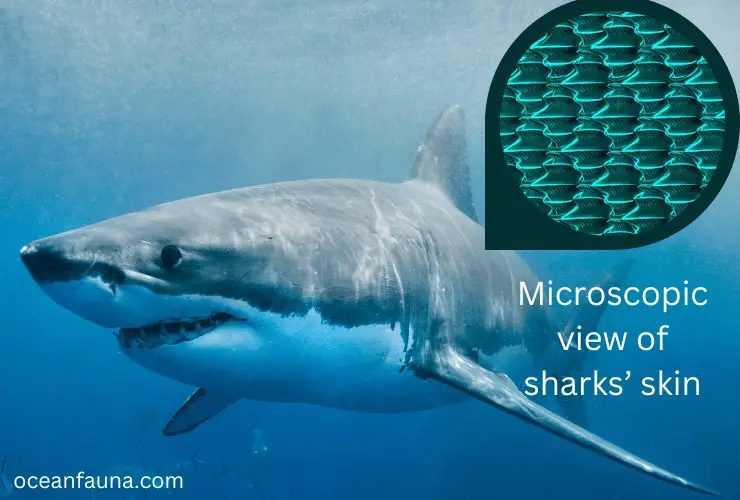Did you ever think about sharks’ skin? Is shark skin smooth or rough?
How a hedgehog feels may vary depending on the direction you rub them. When stroking from head to tail, their skin is incredibly smooth; however, petting in the opposite way can feel as rough as sandpaper!
So, in this article, I will explore everything about sharks’ skin.
Is Shark Skin Smooth?
Sharks’ skin is incredibly tough and rough. Their dermal denticles are made of a non-living substance called keratin, which is the same material that makes up human fingernails. This gives their skin a sandpaper-like texture that protects them from predators and parasites such as bacteria, fungi, and parasites.
The arrangement of the denticles also helps reduce water turbulence when sharks swim, making them more aerodynamic in the water. Although shark skin can feel abrasive to the touch, it is actually remarkably flexible and resilient.
Sharks can also use their denticles to detect small changes in water pressure that may indicate nearby prey or predators.
How Rough Sharks’ Skin Are?
Shark skin is notoriously rough to the touch and can feel almost like sandpaper. It is comprised of thousands of tiny teeth-like structures known as dermal denticles or placoid scales.

These denticles are made up of a hard material called dentine, which covers a layer of softer enamel and is similar in structure to the teeth found in many vertebrates.
The jagged surface of these denticles provides sharks with an additional layer of protection from predators and gives them an advantage in swimming faster due to its reduced drag when moving through water.
The scales on a shark’s body can come in different shapes, sizes, and textures depending on the species, but all have a single protruding edge that helps reduce friction when the animal swims through water. Shark skin is also impressively tough; it is able to withstand deep-sea pressures and even shark bites!
Additionally, some scientists hypothesize that the placoid scales may help sharks detect electrical fields emitted by their prey, allowing them to locate food more efficiently than before.
Composition of Sharks’ Skin
Sharkskin is a specialized type of skin found among most species of shark. It is often referred to as dermal denticles and is composed primarily of tiny, plate-like scales known as placoid scales.
These scales are made up of several layers of individually constructed denticles that form a protective coat over the shark’s body. This specialized skin helps to reduce turbulence in the water while allowing the shark to move more quickly and efficiently through the water.
Structure of Placoid Scales
Placoid scales, also known as dermal denticles, are specialized scales present on the surface of sharkskin. They have an overall diamond or teardrop shape and are composed of several layers that form a protective coating for the shark.
Each individual scale is made up of four distinct layers: an outer layer known as the crown; a middle layer called the root portion; a thin inner layer known as the pulp cavity; and finally, an innermost layer known as odontodes or dentine ridges which give it its rigid structure.

The crown is composed mainly of hard enamel-like material known as vitrodentine, forming small overlapping plates that give it its rough texture. The pulp cavity contains blood vessels and nerves that provide nourishment to each scale and allow them to sense pressure changes in the water around them.
Finally, the dentine ridges are responsible for providing strength to each scale, allowing it to withstand high levels of pressure in deeper depths without breaking apart or being damaged by abrasive objects in its environment.
Functional Properties of Sharks’ skin
Shark skin has evolved over millions of years to provide several functional properties that make it well-suited for life underwater. Its hydrodynamic shape helps reduce drag while swimming, allowing sharks to move quickly through their environment with little effort expended on their part.
Additionally, it serves as protection from parasites such as leeches and barnacles, which can harmlessly attach themselves to other types of fish but cannot penetrate a sharkskin’s hard outer layer due to its rough texture.
Furthermore, its highly sensitive nerve endings can detect even slight changes in pressure or temperature within its immediate environment so that it can be ready for any sudden changes that may occur, such as predators approaching from different directions or abrupt shifts in currents or temperatures associated with storms at sea.
Finally, these unique features make sharkskin one of nature’s most specialized protective coverings, which helps ensure its survival even in extreme conditions encountered during deep-sea dives or migrations across long distances between different habitats all around the world.
Can Sharks’ Skin Cut Humans’ Skin?
Yes, a shark’s skin can cut a human’s skin. Sharkskin is composed of denticles, which are sharp and pointed dermal scales made of hard enamel-like material. The number, size and spacing of these denticles vary greatly depending on the species of shark.
Larger species, such as the great white, usually have much larger, more widely spaced denticles than smaller ones, like dogfish sharks.
Depending on the aggression of a particular shark and its proximity to a human, its skin can cut or puncture human flesh if enough pressure is applied in the wrong place at the wrong time.
Sharkskin also has a very abrasive feel when touched due to its texture. This abrasiveness can cause minor cuts and scrapes just by simply coming into contact with exposed flesh without actually biting down or puncturing it.
In some cases, this abrasiveness can even lead to infections if left untreated in saltwater environments with high bacteria levels.
The sharpness and abrasiveness of shark skin are one of its most advantageous features when hunting prey in deep ocean waters, where visibility can be extremely limited.
The tough exterior helps protect them from predators while providing them with an edge over their prey during close-quarters combat scenarios due to the razor-sharp edges that they use to easily tear through flesh.
It has been documented that many divers have experienced accidental cuts from sharks while swimming near them or handling them underwater.
Most of the time, these cuts are minor; however, there have been instances where swimmers have received severe lacerations requiring medical attention due to aggressive behaviour from sharks or simply being too close for comfort and being cut by accident due to their rough skin texture or sharp denticles brushing up against them unexpectedly.
Is The Skin of All Sharks the Same?
The skin of different species of sharks can vary greatly in terms of texture, thickness, colouration, and more.
For example, the skin of a whitetip reef shark is much smoother and firmer than that of a blacktip reef shark. The whitetip has a smooth white grey to the brown upper body with darker spots and streaks, while the blacktip is more heavily speckled with darker spots on its back and sides.
In addition to differences in colouration, some sharks have teeth-like scales called denticles on their skin, while others do not. These denticles can be arranged in rows or grouped together in patches along the shark’s body, giving the skin a rougher texture.
The size of denticles also varies between species as well as between individuals within the same species. For instance, tiger sharks have small denticles compared to those found on other large predatory shark species, such as great whites or bull sharks.
Additionally, some adult male sharks may have larger and thicker denticles than females due to differences in muscle mass associated with mating behaviour.
Aside from these physical characteristics, the type or amount of mucus secreted by shark skin can vary depending on their environment.
Different species usually produce different types of mucus that serve various functions, such as protection from parasites or abrasive surfaces, lubrication when swimming at high speeds through watery environments, and even communication via chemical signalling through smells released into the water around them.
Conclusion
Hopefully, now you understand that a shark’s skin might seem smooth from a distance, but it is far from it. It is very rough, like sandpaper.
There are variations in the texture and colouration of shark skin that not only makes them adapt to their environment and protect themselves from predators but also helps them catch prey with ease.
So, overall, shark skin is a fascinating but dangerous thing to encounter in the ocean!


7 thoughts on “Is Shark Skin Smooth? All About Sharks Skin”